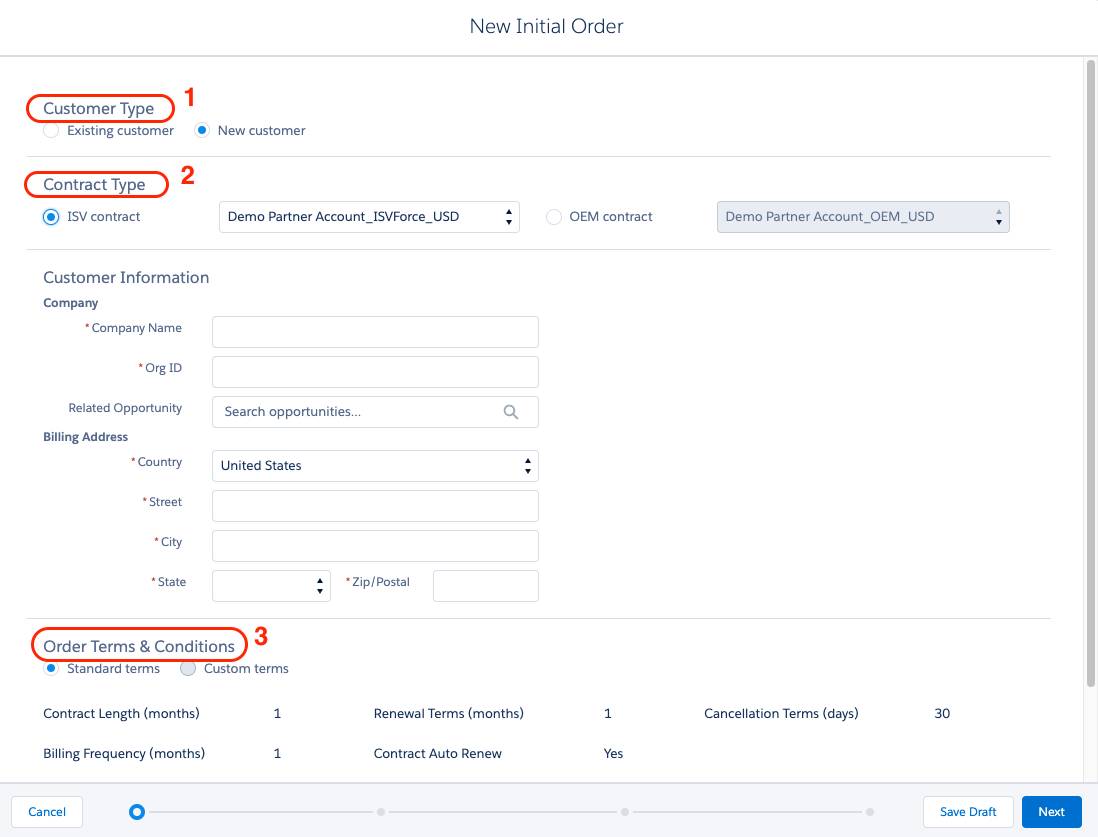Create Orders
Learning Objectives
After completing this unit, you’ll be able to:
- Identify the components of an order.
- Describe how to pick the correct order type.
- Demonstrate order creation using the Channel Order App (COA).
What’s in an Order?
Reporting customer orders by submitting them to Salesforce is an important part of increasing your revenue. When customers buy from you or request changes to what they bought, you create orders in the Channel Order App (COA) to report these sales.
If the COA were a TV show, your order would be the star. It gets top billing because it contains the key details Salesforce needs to provision the order and invoice you: the who, what, how much, and when of the sale. You create an order to aggregate all that information in one place.

Who?
Tell us about the customer who made a purchase or change request (1). For new customers, provide their name, Org or Tenant ID, and billing address. These details are added to the order and create a customer record. For an existing customer order, you don’t have to enter their data again. Either initiate the order from their customer record or use the lookup functionality in the Order Wizard by searching the customer name or Org ID.
What?
Add products to your order to identify new purchases or modifications your customer wants to make. In Unit 1, we talked about how Salesforce uses product catalogs to keep track of the products you sell. Your partner contract includes your product catalogs. Salesforce preloads contracts into the COA. Select a contract (2) to view the terms and access a specific catalog. In most cases, you keep the standard contract terms for every customer order (3). As you choose products for the order, you tie contract terms to the order.
How Much?
Every product you sell has a set pricing structure as your product catalog defines. Products are priced per user or per org (a unit is one user or one org). Keep the unit in mind as you enter order quantity. With percentage net revenue (PNR) priced products, you also enter the customer monthly unit price. Even if you’re contracting with your end customers on an annual basis, you should include the monthly rate in your order submission. The COA automatically calculates the total amount you owe Salesforce for revenue sharing.

When?
There are two key dates on every order: the Service Start Date and the Date Partner Received Customer Order. The Service Start Date is when the customer will begin using your app and the effective start date of their contract. The Date Partner Received Customer Order is when you made the sale to your customer.

You create orders in the COA by putting all these pieces together. Bundle customer info with products and their prices, tell us a few key dates, and you’ve got yourself a shiny new order and a happy customer.
What’s Your Type?
This title is not a cheesy pickup line. Every order has a type. To create an order, the first step is choosing the order type. Type equates to action. It directs the steps you and Salesforce take to process COA orders.
The COA offers several order types. Some partners don’t need every type. Your agreement with Salesforce determines the ones available to you.
You use different order types for different stages of your relationship with your customer: beginning, middle, and end.
| Order Types |
|||
|---|---|---|---|
|
Type |
Stage |
Description |
Effective Date |
|
Initial |
Beginning |
Initiate the first order for a new customer. |
Processed on receipt and effective on the service start date you specify on the order |
|
Add-On |
Middle |
Add additional products or increase the number of licenses on the customer contract. |
Processed on receipt and effective on the service start date you specify on the order |
|
Upgrade |
Middle |
Increase the quantity and price of licenses mid-contract or upgrade the customer to a higher-priced product mid-contract. |
Processed on receipt and effective on the service start date you specify on the order |
|
Reduction |
Middle |
Reduce the number of licenses on the customer contract. |
Contract renewal date—assuming you give proper notice according to your cancellation terms (for example, 30 days notice prior to renewal) |
|
Renewal |
Middle |
Renew a contract that isn’t set to auto renew or change the price of existing products on contract renewal. |
Processed on receipt and effective on contract renewal date |
|
Cancellation |
End |
Terminate the contract with your customer. A cancellation order permanently removes your products from the customer's org. |
Contract renewal date—assuming you give proper notice according to your cancellation terms (for example, 30 days notice prior to renewal) |
|
New Cloud |
Beginning |
Initiate the first order for an existing customer under a separate cloud offering (for example, an existing Sales Cloud app customer also uses your new Marketing Cloud Engagement app offering). |
Processed on receipt and effective on the service start date you specify on the order |
Choose type carefully. Consider whether the order type is compatible with your customer’s current contract, existing products, and org. Compatibility is key to ensuring Salesforce processes the order quickly.
Create an Order
Now let’s put everything we’ve discussed into action and create an order for a new customer. Later, in Unit 4, we create orders to meet existing customers’ needs.
Your company’s sales team has been working with Acme Corp. They have a trial license and love your product. Today, Acme made their first purchase.
Acme signed an agreement to buy 25 users at $100 per month per user. Revenue sharing for your product is PNR at 15%. Their contract is for 12 months with auto renewal. 
Check their license. They already have one, but you need to update it from the trial version. In the License Management App (LMA), update the license to reflect Acme’s purchase: active for 25 users. While you’re in the LMA, grab their org ID.
Next, enter the deal details (the who, what, how much, and when) in the COA:
- Who? Acme is a new customer of yours, so enter their company information including the org ID. Getting the org ID correct is critical to accurate order processing, so make sure you get it right!
- What? Choose your contract and the product from your product catalog.
- How much? Enter 25 for license quantity (licenses are per user, as opposed to per org) and a unit price of $100. Salesforce calculates your revenue sharing total as 15% of your total sale.
- When? Enter the date you want service to start and the date you received the order.
As you put the order together, the COA validates your entries against your contract terms and product catalogs.
Before you can submit the order, you must agree to a few legal terms. Some are general Salesforce terms, such as confirming you’re authorized to submit orders. Others are related to product special terms associated with the products in the order. Agree to the terms, double-check your order details, and submit the order. For more detailed step-by-step COA order submission instructions, see the ISVforce Guide.
You’ve submitted an order for a new customer. Nice job! Now Salesforce can process the order and invoice you. In Unit 3, we look at order processing.
Resources
- Salesforce Partner Community: COA Order Processing Playbook - ISVForce Edition (login required)
- Salesforce Partner Community: COA Order Processing Playbook - OEM Edition (login required)
- Salesforce Partner Community: COA Order Submission Guide (login required)
- Salesforce Partner Community: COA Customer Tenant ID Guide (login required)
- ISVforce Guide: COA: Submit an Order (login required)
